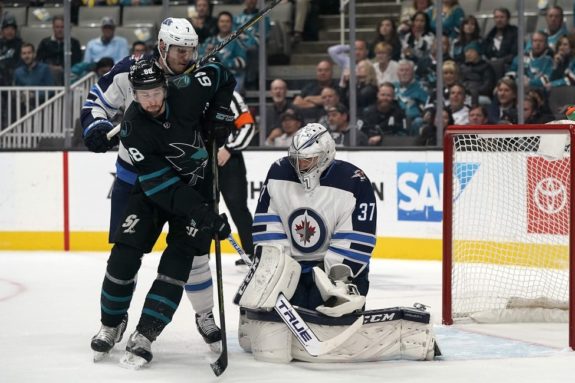The Winnipeg Jets have shown through the first month of the season that they are a playoff team and deserve to be in the conversation of Stanley Cup contenders, but they have one Achilles’ heel that is anything but subtle or secretive. Their ability to defend… let me rephrase that. Their inability to defend the opposition’s power play is like an open wound on bathing suit model. You can mask it with some cosmetics, but in the end, he or she can’t really be put on the cover!
The Jets’ penalty kill is abysmal. At the time of writing this, they are currently 31st in the NHL, with only the Vancouver Canucks behind them. Even the 2-13-2 Arizona Coyotes, the worst team in the league, have a better penalty-kill percentage than the Jets. In fact, every team with 14 points or less, just over half the Jets’ point totals, have a better penalty kill than the Jets. It’s bad. Of the 43 goals the team has allowed this season, 17 have been while trying to kill a penalty. That’s 40 percent of their goals against total and unacceptable for a Stanley Cup contender.

In a 3-2 loss to the Canucks, the Jets gave up two power-play goals, and in a game they dominated at home against the Edmonton Oilers, the only way the visitors got back into the game was from two power-play goals in the third period. It’s an old adage but a true one, “defence wins championships.” Find the last NHL team to win a Stanley Cup that did not have top-notch goaltending, a rock-solid defence or was able to kill penalties at will. Often, champions have had a combination of the three as they are all tied together. We don’t live in the ’80s anymore and the average playoff game isn’t a 6-5 score.
Jets’ Don’t Need to Fix Everything
The fact that they are 9-4-4 demonstrates the rest of their game is going well. When playing 5-on-5, the Jets are outscoring their opposition 43-26 — that is exactly a goal per game advantage. That’s a stat worth contemplating. They are near the top of the league when playing even strength.
They have received excellent netminding from both Connor Hellebuyck and Eric Comrie, who have a combined save percentage of .919. The Jets have allowed a respectable 43 goals this year which translates to 2.53 goals against per game which is 8th best in the NHL. Consider this for a moment, they have the eigth best goals-against average as a team, and yet their penalty kill is atrocious. What would their record be if it was even just average? Goaltending has not been the problem this season, and past season performances would suggest it will not be an issue moving forward this year.
Related: Jets Need to Avoid Oilers’ Power Play to Win
The defence is steadily improving and the team transition game is finally in sync most nights, as they are able to move the puck out of their end and into the hands of the forwards smoothly on most occasions.
Offence Does Not Need to be Fixed
To date, the offence has been the cosmetic plan to hide the wounded penalty kill. The Jets have scored at more than a three goals per game rate and have shared the wealth in that department. Six different players have hit double digits in points including defensemen Nate Schmidt and Neal Pionk, with the bulk of the scoring on the shoulders of trio Kyle Connor with 22 points (12 goals, 10 assists), Pierre-Luc Dubois (10 goals, six assists) and Andrew Copp (five goals, 11 assists) who have 16 points apiece.

However, as of late, the Jets are doing just okay with the man advantage. They have a 21.3 percent success rate, which is 12th in the league. But if you’re a trend follower, they are only 1-for-9 in their last three games and, even worse, only 2-for-19 in their last eight games. That’s a 10.5 percent rate and right now the Pittsburgh Penguins carry the honour for worst power play at 11.5 percent. So, the power play has not been stellar as of late either, and the Jets will need to be cautious here.
Penalty Kill is the Real Achilles’ Heel
The penalty kill is the glaring weakness and has been from the first road trip in October. They are passive and seem to let the opposition move the puck at will, giving up some great scoring chances… obviously! If it were not for the steady play in net, the Jets’ penalty kill would have even poorer numbers.
They have to get more aggressive when they are a man down, force the opposition’s hand and take shots they are not comfortable with. Playing at a quicker pace when defending a penalty does two things, it creates a sense of urgency on the team with the power play. Secondly, this forced urgency leads to poorer passing, which then, in turn, does not allow for as many juicy shot attempts. The Jets need to create a bit of organized chaos when they’re defending and right now they are not. They are allowing teams to set up and strategically move the puck at will to set up what can only be described as a tee shot. More pressure equals less comfortability, which leads to forced passing and less premium scoring chances.
If the Jets are to go on an extended playoff run — and they have the roster to do it — they need serious improvement (From “Blueprint to success there for Jets, but PK still needs works”, Winnipeg Sun, 20/11/21) in their special teams play, especially when they are a man down, and they need to address that open wound quickly. They cannot afford to be giving points away to the likes of Vancouver and other struggling teams in a very tight Central Division.